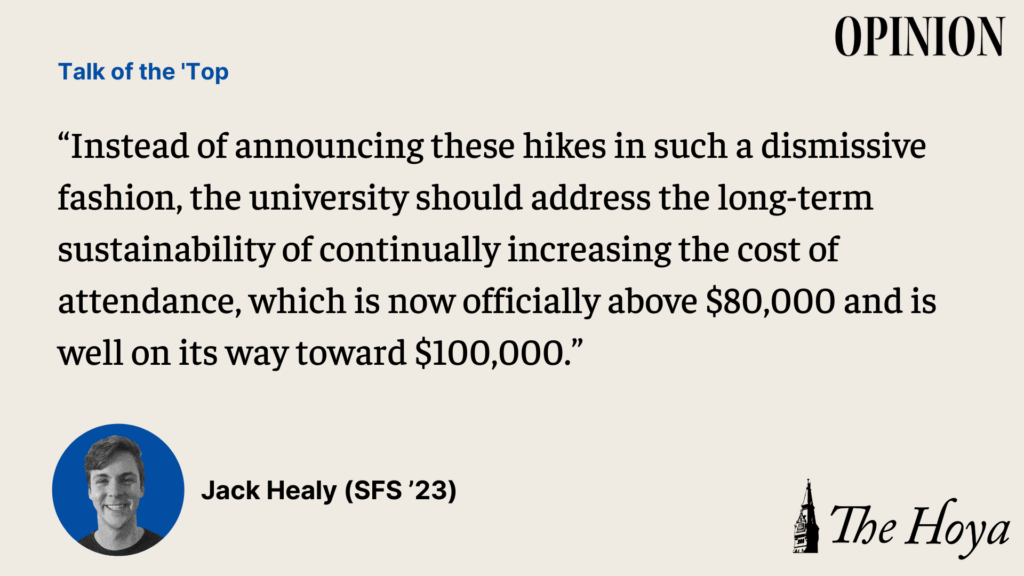In 1982, Jon Reynolds (CAS ’65), the university archivist at the time, wrote an article on the history of Georgetown tuition. He traced that year’s 18% increase in undergraduate tuition all the way back to the university’s first tuition hike, a 15% increase that the mother of Georgetown College’s first student, William Gaston, had to meet to keep Gaston enrolled.
Reynolds was sympathetic to Georgetown’s need for “painful” tuition increases year after year. Writing as both a historian and employee of the university, Reynolds’ perspective was a practical one, and he saw tuition increases as an inevitable outcome. Yet he lamented that the cost of a Georgetown education was “now beyond the means of most of the middle class,” since the university had been fully meeting — he assumed — the financial needs of low-income students since 1978.
Four decades later, runaway tuition increases show no signs of stopping. Last week, the university announced it would raise undergraduate tuition by 3.5% for students returning for the 2022-2023 academic year. I’m not here to argue against the merits of the increases themselves, though there are legitimate questions regarding administrative salaries or the necessity of new schools.
Instead of announcing these hikes in such a dismissive fashion, the university should address the long-term sustainability of continually increasing the cost of attendance, which is now officially above $80,000 and is well on its way towards $100,000. Without simply pointing to financial aid, university administrators should acknowledge how these hikes do nothing to address the well-known reality that roughly 20% of Georgetown students come from the top one percent.
Unlike in 1982, today’s tuition hikes come as annual installments in the story of the skyrocketing costs of American universities and their relationship with structural inequality. They continue here at Georgetown like clockwork. This year’s tuition increase marks the 11th consecutive year that the university has raised the cost of attendance. Next year, tuition will have increased by more than 12% since the Class of 2023’s first year, from $55,440 to $61,872.
With these tuition hikes, administrators repeatedly elude such acknowledgement by pointing each year to financial aid, hiding behind the recycled language of the “largest investment” in the university’s history. As a recently filed class action lawsuit alleges, Georgetown’s commitment to meeting demonstrated financial need may not be as genuine as the university likes to claim. And regardless of aid, the never-ending growth of an already outrageous price tag does not help attract students with any worries about meeting the cost of attendance, nor does it ease any burdens for low-income students.
In all fairness, Georgetown University President John J. DeGioia (CAS ’79, GRD ’95) has addressed the issue of college affordability in the past. In a 2016 interview, DeGioia highlighted the “unsustainable model” of the gap between private universities’ sticker price and what students pay on average after aid, admitting that “we don’t really have a strategy for addressing this at this point in time.” Maybe that non-answer was enough in 2016, but even six years later, no university administrator has come up with any such strategy.
In an interview from November 2020, DeGioia, who serves as the head of the 568 Presidents Group currently being sued for dubious financial aid practices, again discussed the college affordability problem. Yet again, his answer fell short. Always the academic, he asked himself about “ways in which together we may be able to address the cost curve” for private universities, but stopped short of offering any candid exploration of possible solutions.
Despite DeGioia’s responses, however, the university continues to raise tuition each year without any real acknowledgement or discussion of the effects on students or the overall socioeconomic makeup of the student body. On cue, students react to the increases, correctly claiming that higher prices adversely affect low-income students — both current and prospective. Students also call year after year, seemingly in vain, for increased transparency and student input in the tuition decision-making process.
Can these tuition increases continue forever? What is the endgame of these hikes? I don’t know the answers to these questions, but university administrators should meaningfully address them and engage students while doing so.
Although Reynolds already recognized 40 years ago that the price of a Georgetown education was “beyond the means” of most families, the school continues to become less affordable and even less socioeconomically representative of the country. Is that the type of campus community university administrators want to maintain?
Jack Healy is a junior in the School of Foreign Service. Talk of the ’Top is published every other week.














